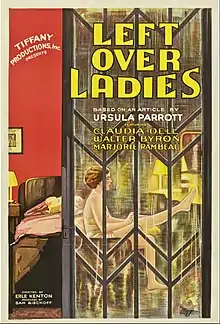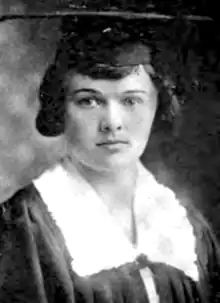Ursula Parrott
Ursula Parrott (March 26, 1899[1] – September 1957), was an American writer of romantic novels. Her first book, Ex-Wife (1929), was a best seller, and was adapted for film as The Divorcee, starring Norma Shearer. Exploring changing sexual mores and their implications for women, Ex-Wife was considered scandalous in its time.[2][3] From 1930 to 1936, Parrott sold the rights to eight novels and stories that were made into films.[2]

Ursula Parrott | |
|---|---|
 Ursula Parrott, from the 1920 yearbook of Radcliffe College | |
| Born | Katherine Ursula Towle March 26, 1899 Dorchester, Boston, Massachusetts, United States |
| Died | September 1957 (aged 58) New York City, United States |
| Language | English |
| Nationality | American |
| Genre | Romantic fiction |
| Spouse | Lindesay Marc Parrott Sr.
(m. 1922; div. 1928)Charles Terry Greenwood
(m. 1931; div. 1932)Alfred Coster Schermerhorn
(m. 1939; div. 1944) |
| Children | Lindesay Marc Parrott Jr. |
Personal life
Ursula Parrott was born Katherine Ursula Towle in Dorchester, Massachusetts. Her father was Dr. Henry Towle[4] and her mother was Towle's second wife, Mary Catherine Flusk.[5] Towle's first wife, Elizabeth Mooney, had died shortly after giving birth to a daughter, Margaret. Parrott's older half-sister would later adopt the name Madge Tyrone.[4]
Parrott graduated from Radcliffe College, a small women's liberal arts college in Cambridge, Massachusetts.[1] After graduation she moved to Greenwich Village, where she met Lindesay Marc Parrott in 1920.
In 1922, Ursula married Parrott, who at the time was a reporter for The New York Times. They had a son named Lindesay Marc Parrott, Jr., two years later. However, Parrott, Sr., didn't want a son and the baby's existence was kept a secret. Ursula left the child in the custody of her father and sister. It wasn't until 1924 that Parrott, Sr., found out that he was a father. He divorced her and denied the existence of the child. Ursula, however, saw her son often, brought him gifts, and eventually gave him a Harvard education.
Ursula had married three other men, Charles T. Greenwood, a prominent New York banker, in 1934; John Wildberg, an attorney, in 1937; and Air Force Major Coster Schermerhorn (grandson of Charles Coster) in 1945. She continued to be involved with Wildberg and was also rumored to have had affairs with F. Scott Fitzgerald and Sinclair Lewis.
Parrott died of cancer in the charity ward of a New York hospital in 1957 at the age of 58.
Career
Parrott's Ex-Wife, her first novel, was published anonymously in 1929.[6] A popular sensation, it sold more than 100,000 copies in nine editions.[3] MGM paid $20,000 for the film rights as well.[2] Ex-Wife was adapted for film as The Divorcee (1930) starring Norma Shearer, who also starred in an adaptation of Strangers May Kiss, published in 1930. Her novel Next Time We Live was adapted for film as Next Time We Love in 1936.[7] As a writer, Parrott was most successful between 1929 and 1940. Her son estimated that she earned around $700,000 ($14.6 million in 2022 dollars) during that period of time.[2]
In December 1942, Parrott became the subject of national coverage when she was brought up on federal charges of attempting to help the jazz guitarist Michael Neely Bryan escape from the Miami Beach Army stockade,[8][9][10] but was found innocent by the jury at her trial.[11][12]
See also
References
- Radcliffe College, Yearbook (1920): 67. via Hathi Trust
- "Formerly Famous: Ursula Parrott ⋆ Cladrite Radio". cladriteradio.com. Retrieved 2019-09-26.
- LaPointe, Michael (February 12, 2019). "The Racy Jazz Age Best Seller You've Never Heard Of". The Paris Review.
- Gordon, Marsha (2023). Becoming the Ex-Wife: The Unconventional Life and Forgotten Writings of Ursula Parrott. Oakland, California: University of California Press. p. 12. ISBN 978-0-520-39155-0.
- Gordon, Marsha (2023). Becoming the Ex-Wife: The Unconventional Life and Forgotten Writings of Ursula Parrott. Oakland, California: University of California Press. p. 13. ISBN 978-0-520-39155-0.
- "Books: Man Leaves Woman". Time Magazine. August 26, 1929. Archived from the original on October 27, 2010. Retrieved May 7, 2011.
- Frank S. Nugent (January 31, 1936). "Next Time We Love (1936) THE SCREEN; Talkative Is the Word for 'Next Time We Love,' Current at the Radio City Music Hall". New York Times. Retrieved May 7, 2011.
- "U.S. At War: The New Ursula Parrott Story". Time Magazine. January 11, 1943. Archived from the original on December 14, 2008. Retrieved May 7, 2011.
- "Ursula Parrott is Indicted On Three Federal Charges". St. Petersburg Times. January 9, 1943. p. 9. Retrieved May 7, 2011.
- "Novelist Seen Making Love In Army Stockade". The Pittsburgh Press. February 26, 1943. p. 14. Retrieved May 7, 2011.
- "Ursula Parrott Freed of Federal Charges". The Tuscaloosa News. February 28, 1943. p. 10. Retrieved May 7, 2011.
- New York Evening Post, Dec. 30, 1942 (AP) "Ursula Parrott, the author, in a press statement today took full responsibility"
Works
Further reading
- Marsha Gordon: Becoming the ex-wife: the unconventional life and forgotten writings of Ursula Parrott, Oakland, California : University of California Press, 2023, ISBN 978-0-520-39154-3
External links
| Library resources about Ursula Parrott |
| By Ursula Parrott |
|---|
- Works by Ursula Parrott at Faded Page (Canada)
- Ursula Parrott at IMDb
- Westall, Susan - The Development of a Bio-Bibliography for Ursula Parrott with Indexing and Navigation Tools in Printed and Web-Based Versions (Master's Research Paper, Kent State University) - Education Resources Information Center
- Ursula Parrott books.google.com